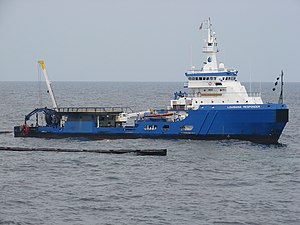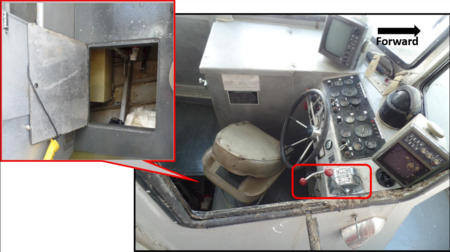Louisiana Responder
The Louisiana Responder is an oil recovery vessel of the Responder class.[1]
On January 16, 2019, during a training drill, her auxiliary boom vessel capsized, killing the boat's crew - a pilot and a deckhand.[2][3]
Complement
Responder class vessels have a permanent crew of six mariners.[1] When deployed to counter a spill they will be joined by additional staff of seven environmental technicians to operate her oil spill equipment. The staff who operate the oil spill equipment are not permanently assigned to the vessel.
The loss of the boom vessel, MSRC 8-1, and her crew
On the morning of January 1, 2019, the Louisiana Responder was to deploy her boom downstream of New Orleans, Louisiana, near the mouth of the main channel of the Mississippi River.[4] The chief of the land-based responder team, a 48 year old man, with over a decade of experience, was to pilot the boom vessel. His deckhand was a 24 year old woman, the least experienced member of the team. Her role would primarily consist of handling the line the skimmer hung from.
When operating in on waters where there is a pronounced current the boom vessel deploys from the stern of the Responder along a 'J' shaped route, upstream.[4] This catches surface oil in the bight of the skimmer boom, which is then swept down to the Responder's stern, where it can be vacuumed up by the Responder's pumps.
The manufacturer's manual for the boom vessel warns operators to never let the towline go more than ten degrees from the vessel's centreline, or the vessel might capsize.[4] Observers on the Louisiana Responder saw the boom vessel make a turn to starboard at approsimately 10:38, followed almost immediately by a large turn to port. The vessel did then capsize.
Elements of the United States Coast Guard were nearby, and were on scene promptly.[4] The USCG boat 45707 was present, as was a USCG helicopter. A USCG rescue swimmer dove in, and made contact with the capsized boom vessel. The water was 43 degrees fahrenheit. Normally, in this temperature, a swimmer would use a "dry suit", and he was only equipped with a "wet suit". Nevertheless the swimmer was able to submerge, and search for the boom vessel's doors. That search was unsuccessful.
He was able to communicate with the vessel's pilot.[4] He said his deckhand had already been swept away, and that the pilothouse was dark, and he could not locate the pilothouse doors. The swimmer tried to guide him to the rear of the pilothouse, to help him find the doors, without success.
In its maneuvering the 45707's prop wash was accidentally directed into the capsized boom vessel, and the swimmer saw bubbles from the airpocket the survivor was relying on leave the vessel.[4]
When the sunken boom vessel was recovered they found the deckhand's life preserver inside.[4] She had, however, been seen wearing a flotation suit.
The NTSB accident report, published 18 months later, noted that none of the boom vessel's windows were designed to open to provide an emergency exit.[4]
References
- ↑ 1.0 1.1 Marine Accident Brief: Capsizing and Sinking of Workboat MSRC 8-1, National Transportation Safety Board. Retrieved on 2022-08-01.
- ↑ NTSB: Workboat’s angle to strong current resulted in fatal capsizing, Professional Mariner, 2020-07-19. Retrieved on 2022-08-01. “The National Transportation Safety Board determines the probable cause of the capsizing of the workboat MSRC 8-1 was the boat becoming perpendicular to a strong river current, for an undetermined reason, while tethered to Louisiana Responder. Contributing to the accident was the unforeseen risk associated with conducting the exercise in a strong current, which also contributed to the severity of the outcome by hampering rescue efforts.” mirror
- ↑ Frank McCormack. NTSB Releases Accident Report On 2019 Sinking Of OSRV Assist Vessel, Waterways Journal Weekly, 2020-07-27. Retrieved on 2022-08-01. “On the morning of the incident, a team of seven MSRC land-based responders and a federal Bureau of Safety and Environmental Enforcement (BSEE) observer boarded the Louisiana Responder, joining the vessel’s crew of six for an oil spill containment exercise to be held downriver at the Boothville Anchorage.” mirror
- ↑ 4.0 4.1 4.2 4.3 4.4 4.5 4.6 4.7 The Capsizing and Sinking of Workboat MSRC 8-1, Marine Construction magazine. Retrieved on 2022-08-01.


